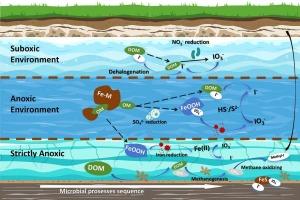多层氧化还原动态地下水系统中天然有机质驱动碘生物地球化学循环
IF 6.3
1区 地球科学
Q1 ENGINEERING, CIVIL
引用次数: 0
摘要
地下水碘(I)富集是在受复杂的水-生物地球化学过程控制的广泛氧化还原条件下观察到的。然而,不同氧化还原梯度的主导过程仍不清楚。本研究选择了I浓度较高的现场,建立了20 m × 30 m × 40 m × 50 m(深度)的多级监测井。对地下水进行了化学分析,并进行了有机质(OM)荧光和分子分析以及宏基因组学分析,以确定控制地下水中I富集的主要生物地球化学过程。在缺氧环境下,酚类和饱和富烃芳香OM为固氮和脱卤微生物提供能量,促进Fe-NOM配合物的I脱附。降解产物,如小有机酸,支持硝酸盐还原(narL, narBHY和nir)和碘化物的形成。在缺氧条件下,Desulfovibrio和dissimilatory sulfate reduction (aprAB和dsrAB)通过解吸、脱碘和还原来增强I的富集,并得到饱和和脂肪化合物途径的支持。在严格缺氧条件下,发酵菌分解络合物OM,促进Fe-NOM的溶解,为铁还原菌提供底物,导致I的广泛释放。次级硫化铁的吸附和甲基转移酶(mtrABC和mtaA)的甲基化作用部分限制了I的浓度。本研究提出了一个理论模型,阐明了地下水中微生物的动员机制,强调了有机质的降解优先级是一个关键的制约因素。本文章由计算机程序翻译,如有差异,请以英文原文为准。

Natural organic matter drives iodine biogeochemical cycling in multi-layered redox dynamic groundwater systems
The iodine (I) enrichment of groundwater is observed under wide redox conditions that are controlled by complex hydro-biogeochemical processes. However, the dominant processes across different redox gradients remain unclear. In this study, a field site having a high I concentration was selected, and multi-level monitoring wells [20 m × 30 m × 40 m × 50 m (depth)] were established. The groundwater chemistry was determined, and organic matter (OM) fluorescence and molecular analyses, as well as metagenomics analyses, were performed to identify the dominant biogeochemical processes controlling I enrichment in groundwater. In suboxic environments, phenolic and saturated hydrocarbon-rich aromatic OM provided energy for nitrogen-fixing and dehalogenating microbes, facilitating I desorption from Fe-NOM complexes. Degradation products, such as small organic acids, supported nitrate reduction (narL, narBHY, and nirS) and iodide formation. Under anoxic conditions, Desulfovibrio and dissimilatory sulfate reduction (aprAB and dsrAB) enhanced I enrichment through desorption, deiodination, and reduction, supported by pathways involving saturated and aliphatic compounds. Under strictly anoxic conditions, fermentative bacteria decomposed complex OM, promoting Fe-NOM dissolution and supplying substrates for iron-reducing bacteria, leading to extensive I release. Adsorption by secondary iron sulfides and methylation by methyltransferases (mtrABC and mtaA) partially restricted I concentrations. This study presents a theoretical model that clarifies microbial I mobilization mechanisms in groundwater, highlighting OM degradation prioritization as a key constraint.
求助全文
通过发布文献求助,成功后即可免费获取论文全文。
去求助
来源期刊

Journal of Hydrology
地学-地球科学综合
CiteScore
11.00
自引率
12.50%
发文量
1309
审稿时长
7.5 months
期刊介绍:
The Journal of Hydrology publishes original research papers and comprehensive reviews in all the subfields of the hydrological sciences including water based management and policy issues that impact on economics and society. These comprise, but are not limited to the physical, chemical, biogeochemical, stochastic and systems aspects of surface and groundwater hydrology, hydrometeorology and hydrogeology. Relevant topics incorporating the insights and methodologies of disciplines such as climatology, water resource systems, hydraulics, agrohydrology, geomorphology, soil science, instrumentation and remote sensing, civil and environmental engineering are included. Social science perspectives on hydrological problems such as resource and ecological economics, environmental sociology, psychology and behavioural science, management and policy analysis are also invited. Multi-and interdisciplinary analyses of hydrological problems are within scope. The science published in the Journal of Hydrology is relevant to catchment scales rather than exclusively to a local scale or site.
 求助内容:
求助内容: 应助结果提醒方式:
应助结果提醒方式:


